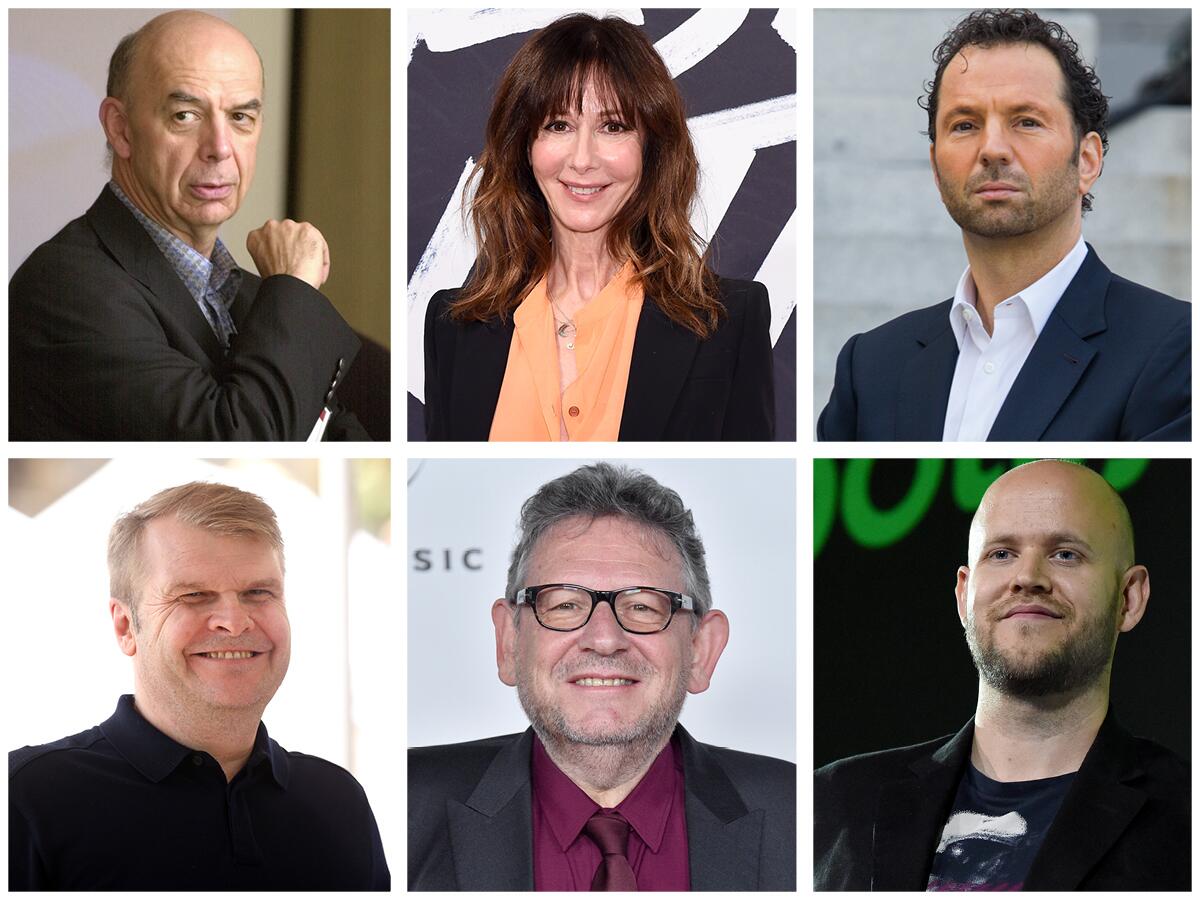Top music industry executives still overwhelmingly white and male, says USC report

- Share via
After a year of public displays of introspection concerning diversity and inclusivity in the entertainment industry, a new study from USC tracking the race and gender of top executives in the music business shows how much work is yet to be done.
The study from USC’s Annenberg Inclusion Initiative, released Tuesday morning, spells out just how stratified the music industry remains in its executive and professional ranks. This is in stark contrast to popular music’s leading streaming and airplay charts, which are regularly topped by Black and female artists.
The study surveyed a broad range of 4,060 executives at 119 music groups, record labels, music publishers, live promoters, radio companies, streaming services and other major and independent music firms. It found that of the top executives at 70 leading music companies, 86% were men and 86% were white. In those 70 companies, there were only three Black top executives and two women of color. At nine key firms (Live Nation, AEG Presents, Sony Music, Universal Music Group, Warner Music Group, Spotify, iHeart Radio, Cumulus and Audacy), every chief executive was white and only one was female. Looking at executives ranked vice president and above at those 119 companies, only 19.8% came from underrepresented minority groups and only 7.5% were Black.
The music divisions of larger companies like Apple, YouTube and Amazon were also overwhelmingly white and male.
Live music and concert promotion companies had the lowest percentage of underrepresented executives of color (12.5%) and had no Black executives. They did have the highest percentage of women in leadership roles, at 40.6%.
Hollywood’s history with Latino representation is a muddy mess. Why even Washington politicians are taking action.
“Some major corporations need an overhaul of their culture internally. There might be some things going right, but there’s also a lot going wrong,” said Stacy L. Smith, a co-author of the study. “When it comes to an inclusive work environment, they have to signal to talent that organizations will foster inclusion and belonging. It’s really clear that a lot isn’t working.”
The study did find that certain lanes of the music industry, like A&R and management, got closer to proportional representation: 34% of A&R representatives were from underrepresented groups, with 21% Black. It also found that more than 80% of underrepresented artists had at least one manager, agent or publicist from an underrepresented racial or ethnic group, while three-quarters of white artists had no underrepresented team members. Most non-Black artists (87.5%) had no Black representatives.
“The people who work closest with artists show the most inclusion, and that’s a strategy organizations need to think about,” said Katherine Pieper, the paper’s co-author. “That’s happening at labels and some management firms, but we need to move it to other place like agents and PR.”
In a segment of the study that included music groups, labels, publishing, radio, streaming and live music, women of color held only 3.2% of top executive jobs, a figure that the study’s authors said was indicative of the different experiences of minority women in the music business compared to white peers.
“We always get surprised, but we shouldn’t be, about the lack of Black women across the entertainment business, whether it’s film or TV and music,” Smith said. “There’s a whole group of individuals who are talented and motivated, but routinely, in all spaces, across sectors, women of color are shut out.”
The assumptions about who gets considered for executive roles need to be reexamined, Smith said.
“There’s no reason not to have multiple candidates who look like the world we live in. Casting a wider net is important,” Smith continued. “But that doesn’t always get at the biases at an organization. There’s got to be criteria beforehand, you can’t write criteria just to fit the person you want to hire. Organizations have to confront their biases.”
Bodega coffee and raps about gentrification — we reflect on everything riding on Lin-Manuel Miranda’s cultural unicorn
One key step, Smith and Pieper said, is that superstar artists can quickly take initiative on this and structure their returns to the stage and their choices in colleagues with these goals in mind. If the industry drags its feet on diversifying, talent can push it in better directions.
“Caucasians just don’t seem to think this work is as important, and that’s where this change needs to happen,” Smith said. “If Taylor Swift or Adele is playing a venue, they can stipulate that among the people providing services at these venues, they want to see more minority- and women-owned businesses as suppliers. This this can change the ecosystem of the business overnight.”
In 2018, USC’s Annenberg Inclusion Initiative released a study of Grammy nominees’ diversity, reporting that 90.7% of nominees between 2013 and 2018 were male. It also tracked abysmal figures for Latin representation in Hollywood films and how a lack of diversity has cost the film business billions of dollars.
More to Read
The biggest entertainment stories
Get our big stories about Hollywood, film, television, music, arts, culture and more right in your inbox as soon as they publish.
You may occasionally receive promotional content from the Los Angeles Times.












